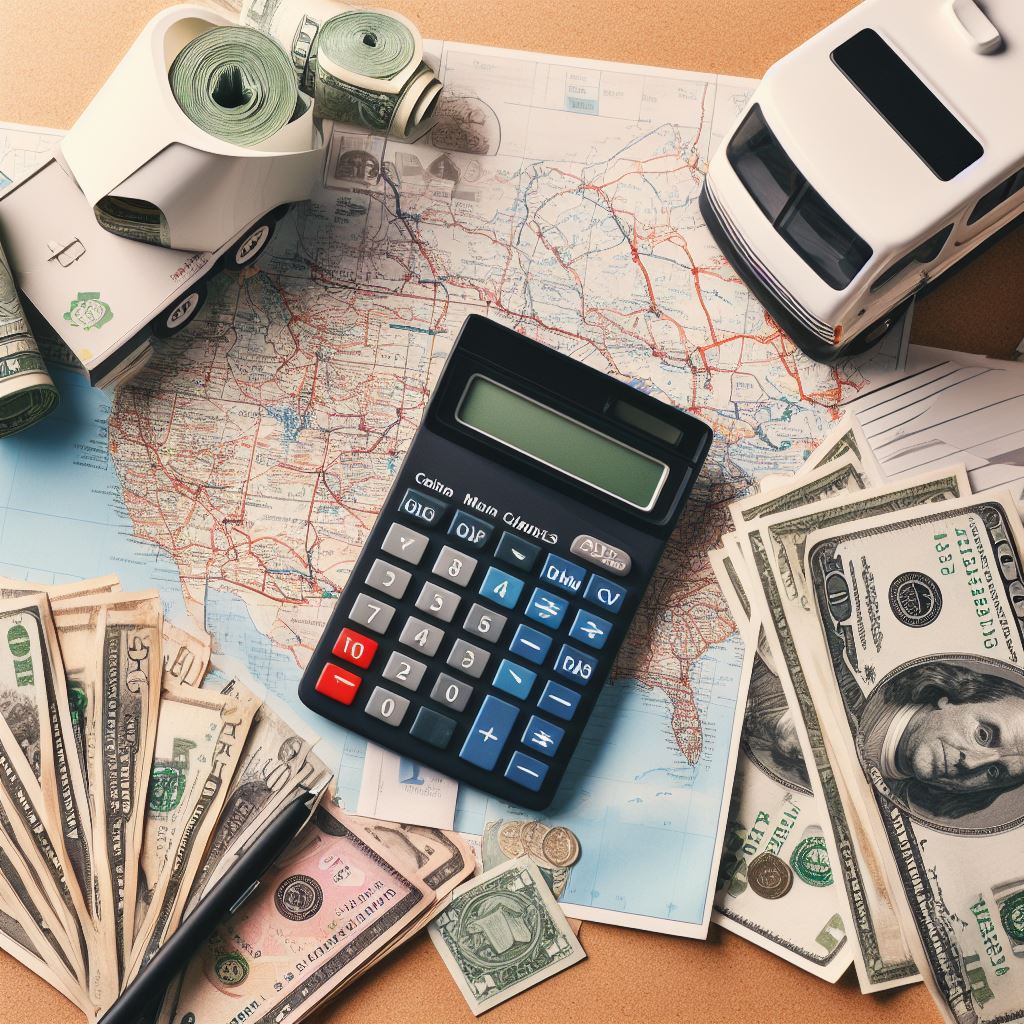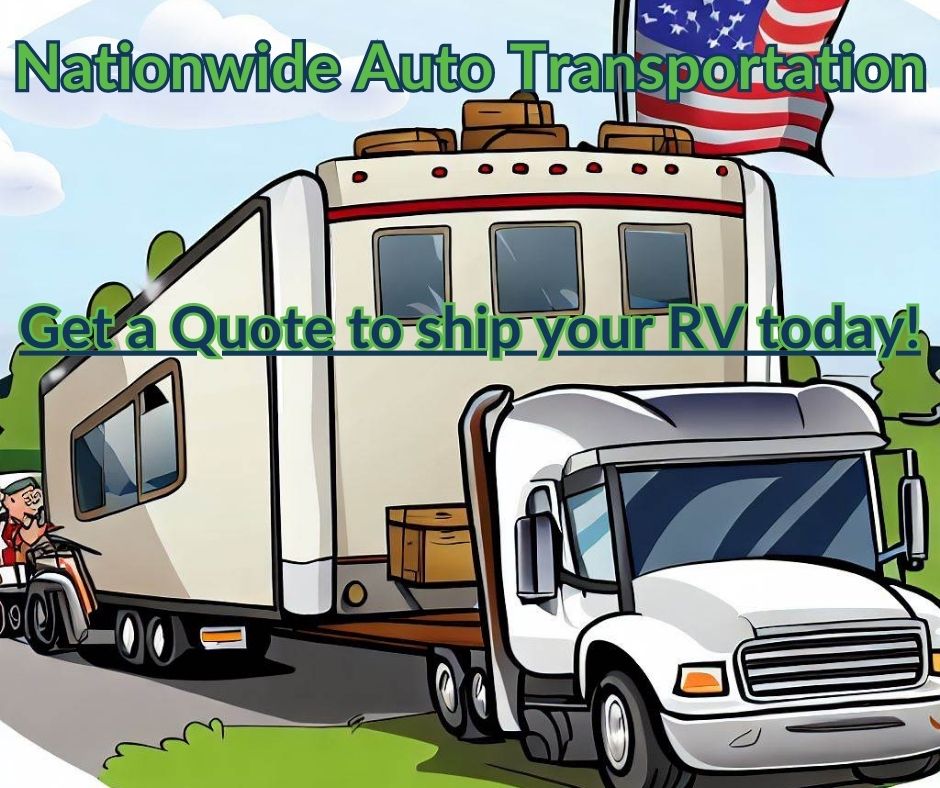
Reading Time: 14 minutes
Hello there, dear reader! 🚗 If you’re considering a big move or embarking on an extended RV trip, you may find yourself in a tricky situation– should you drive your RV all the way, or would shipping it be a better choice? If this dilemma sounds familiar, then my friend, you’ve come to the right place.
In this article, we’ll explore the ins and outs of RV shipping vs. driving cost comparisons, aiming to help you make the most informed decision for your situation.

Need to move your RV in a hurry? Don’t compromise on time or safety. Check out our comprehensive guide on Expedited RV Transport Services to find out how you can have both!
By breaking down the average costs of both options, examining specific variables that could affect the long-distance shipping cost, and even discussing the several types of shipping methods available, this piece is your one-stop guide. Understand the benefits of choosing to ship your vehicle, alongside exposing the impact of auto shipping on insurance and mileage. We’ll also dive into any advanced shipping options that you might want to consider.
Additionally, I’ll guide you through the temporal factors that can drastically affect shipping costs, like seasonal factors. So, stick around and let the journey begin. Buckle up and let’s hit the road to understanding!
Exploring the Frontier of RV Transport? Discover the ultimate in convenience and flexibility with our latest offering: Flatbed RV Shipping Solutions. If you’ve been wondering how to transport your larger-than-life RV with ease, our spacious and versatile flatbed carriers are the answer. Learn why this method is the top choice for seasoned adventurers and how Nationwide Auto Transportation ensures your RV’s journey is as grand as the destination itself!
“Interested in learning more about snowbird car shipping routes? Dive into our comprehensive guide at Nationwide Auto Transportation where we explore the most popular routes, key considerations, and expert tips for a smooth snowbird season transit. Whether you’re a seasoned snowbird or planning your first winter escape, this guide is packed with valuable information to ensure your vehicle’s safe and timely transportation.”
Average Costs | Driving vs. Shipping
You’ve probably had this dilemma once, twice, or a few times in your life: “Should I drive my car or should I hire a professional auto transport service?” To help you arrive at a decision, let’s explore the costs associated with both scenarios. This is no mere excessive, research-driven reasoning. Trust me, your wallet will thank you later! 💸
Curious about the future of vehicle transportation? Don’t miss our latest article, ‘Professional Vehicle Transportation: Benefits and Trends.’ Discover the eco-friendly innovations, cost-saving insights, and more that are shaping the way we move our vehicles.
Cost of Driving Your Car
Whenever we think about moving our vehicles from point A to point B, the first thought that instinctively comes to mind is driving. “It’s my car. Of course, I should drive it myself”. But wait! Just hear me out because driving can have more costs than you likely have anticipated.
On average, the total cost of driving works out to be around $530. This figure doesn’t just include the amount you’ll spend on your gas – add in meals, accommodation if it’s a long haul, and the ultimate hidden cost – depreciation due to added mileage.
Still, you might be thinking – “Why hire someone when I can drive my own car for less?” Well, let’s dive into the world of professional auto transportation, and you’ll see the other side of the coin. According to the U.S. Department of Transportation, the average American drives over 13,000 miles annually.
Planning an International RV Adventure? 🌍🚐
Before you hit those global roads, it’s crucial to know the ins and outs of international RV shipping. From regulations to best practices, our latest guide covers it all. Read more to make your overseas journey seamless: International RV Shipping Guidelines.
Cost of Hiring a Professional Auto Transporter
When it comes to transporting your beloved motor vehicle, professional auto transportation companies can save you from the aforementioned stress attached to driving. These transportation wizards can make your car magically appear on your new driveway while you sit back and relax!
“Hiring professionals will cost me a hefty sum,” you might be thinking now. Surprisingly, it’s not quite as much as you fear! The average cost of engaging a professional auto transporter is $710.
You might ask, “Why is there such a vast range in price?” Well, car shipping costs hinge on several key metrics, spanning from vehicle size and weight to route and even seasonal demands. Typically, it fluctuates between $0.60 and $1.70 per mile.
The American Automobile Association (AAA) often highlights the hidden costs associated with long road trips.”
A bit more expensive than driving? Yes. Worth it? Absolutely!
Spending that little extra not only relieves the stress of a long drive but also saves on the potential damages your vehicle could face on the open road. Plus, if you ever need to transport an RV, the professional route is undoubtedly the wiser option. Though it’s best to explore RV Shipping Costs for a more accurate estimate before you make your decision.
So, the next time you find yourself contemplating whether to drive or to ship – remember, no choice is universally the “right” one. It largely depends on each individual’s circumstance, preference, and whether we value money or time more – a classic conundrum, isn’t it?
Long-Distance Shipping: Costs and Variables
When you’re looking to ship a hefty item —let’s say, a car— from one end of the country to the other, a multitude of factors come into play. With so many elements to juggle, it’s no surprise that costs might seem daunting. But don’t worry! I’m here to break it down and help you navigate the path of long-distance shipping like a pro! 🚚 💪
Fuel Consumption and Driver’s Wages
One of the prime determinants of long-haul shipping prices tends to be fuel consumption. The longer the trip, the more fuel your transporter will consume. Therefore, a direct correlation between distance and price becomes evident.
Also, let’s not forget our heroes behind the wheels — the drivers! More miles on the road translate into more hours and days on the job. So, naturally, their wages are factored into the final costs. 🚛👨✈️
- Fuel costs and driver’s wages tend to increase in tandem with distance.
- Always factor in these variable costs when planning for long-distance shipping.
RV Shipping vs. Driving Costs | Shipping Costs for Distances of 1,000 to 2,000 Miles
When tackling the country’s width, on a span between 1,000 to 2,000 miles, you should set your cost expectations according to the industry standards. Typically, the price for shipping a car over such distances hovers around $1.25 per mile.
RV Shipping vs. Driving Costs: However, remember the nature of long-haul transport. There’s more than just the destination’s distance. Different vehicle types can significantly swing your final invoice. For instance, the costs to ship a car might be starkly different from the costs for Recreational Vehicle Transport.
So, bear in mind:
- Transporting over 1,000 to 2,000 miles typically costs around $1.25 per mile.
- Vehicle type plays a crucial role in determining the ultimate cost.
See? Understanding long-distance shipping costs isn’t that tricky! With these insights, you’re on your way to planning a successful cross-country transport venture. Go forth and conquer those miles! 🙌🌏💼
Looking to ship your RV across the country? Check out our comprehensive guide on Cross-Country RV Shipping to find out everything you need to know.
Shipping Types: Open vs. Enclosed
Let’s dive into the world of auto transportation, shall we? Today, we’re tackling a question that baffles many: to choose open or enclosed shipping? When you have to ship a vehicle—maybe you’re moving across the country, or perhaps you’ve finally bought your dream car online—you want to be sure it arrives safely and in perfect condition. And that’s where your choice of shipping type comes in.
Now, there are two main types: open shipping and enclosed shipping. Which one is the better choice? Well, it’s not that black and white, my friend. It all depends on various factors, including the value of your vehicle, your budget, and your timing. No need to fret, though. We’re going to dissect both methods, comparing costs and laying down the pros and cons of each method. So, buckle up and let’s dive in!
Comparing Costs | RV Shipping vs. Driving Costs
Let me say this straight-up: Enclosed shipping is the pricier of the two methods. Now, that might have made some of you gasp, but hold on, it’s not all about the price tag. While enclosed shipping is more expensive than open transport, it offers a level of protection and security that open shipping can’t. It’s like a safety blanket for your beloved vehicle as it goes off into the wide world (or across a handful of states).
With open transport, it’s generally less expensive than enclosed transport (Yaay! 🎉). It comes with its own set of perks and quirks. It’s like riding on a rollercoaster without a safety harness—not as dangerous, I promise! But you get the thrill of the ride.
When To Ship Your RV | Pros and Cons of Each Method
So, what are the upsides and downsides of both methods? Let’s look at enclosed transport first:
- Pros:
- Superior protection from weather elements and road debris
- Ideal for high-value cars
- Extra insurance coverage
- Cons:
- More expensive
- Can take longer due to fewer carriers available
As for open shipping, here are the points to keep in mind:
- Pros:
- More affordable
- More availability and flexibility in shipping times
- Cons:
- Exposed to weather elements and road debris
- Less secure
Whether it’s enclosed or open shipping, the method you choose depends heavily on what you’re comfortable with and what your vehicle shipping needs are. If you’ve got a fancy, high-end car, you might want to put it in a safe cocoon – enclosed transport. If you’re looking to ship a standard model with a tighter budget, it might be better to go with open transport. Remember: it’s your car, your money, your choice.
The Environmental Protection Agency (EPA) provides insights into the environmental benefits of reducing long road trips
I’ve got a blog post about shipping recreational vehicles that you might find interesting if you’re looking to delve deeper into the subject. Check it out!
Phew! That was a lot to take in, wasn’t it? But I hope it’s given you some clarity on the two shipping methods. And just remember, whether you choose open or enclosed shipping, your vehicle will get to its destination. Happy shipping, folks! 🚗💨
Benefits of Shipping Your Vehicle Instead of Driving | When To Ship Your RV
Hey there, have you ever contemplated shipping your car instead of driving it long distances? 🚗💭 Picture this: no excessive mileage, no unforeseen expenses, and none of that tedious time on the road. Sounds good, right? Here’s my scoop on why you might want to consider shipping your vehicle instead of driving it.

Preventing Wear and Tear
Let’s start with an undeniable fact, driving your car long distances can cause substantial wear and tear. 🛣️ More mileage means more maintenance – and we all know that maintaining a car ain’t cheap. But guess what? By shipping your vehicle, you can circumvent this entirely. Just hand over your car keys to the professionals and let them do all the work while your car enjoys a stress-free, mileage-free journey.
Cutting Extra Expenses
When planning a cross-country drive, you have to keep an eye on certain inevitable expenses. Fuel, food, overnight stays, and the not-so-occasional caffeine hit to keep you going. 🍔💸 Trust me, these costs can add up pretty quickly. Shipping your car instead can be surprisingly cost-effective, helping you dodge those extra journeys to the gas station and those overnight hotel stays.
Saving Time | RV Shipping vs. Driving Costs
As the saying goes, “Time is money,” – and long-distance driving takes loads of it. ⏰ Shipping your vehicle can save you a considerable amount of time, freeing you up to focus on the things that truly matter. This time could be used to rest, work, or even explore your new neighborhood if you’re relocating.

Limiting the Risk of Damage
Accidents happen – and not just the kind that involve other cars. Bad weather, road debris, or even a misguided bird can all cause unforeseen damage to your vehicle. 🚘🌧️ But by choosing to ship your car, the risk of these sources of damage drops significantly. Shipping prioritises the safety of your vehicle from start to finish.
Flexibility
Lastly, have you ever thought about how much flexibility shipping your vehicle offers? You don’t have to worry about driving hours or traffic constraints. Even if you own a big RV, you can still easily ship it, just like I did – check out my experience on why Benefits of Shipping an RV were a game changer for me.
All in all, shipping your vehicle rather than driving it yourself is something to seriously consider, especially if you have an upcoming long-distance move. It might just save you time, money, and the hassle of driving. Let’s be real – who wouldn’t want that? 🤷♀️
So, next time you need to move a vehicle a long distance, think about these points. I bet choosing to ship your car will start to look a lot more appealing. 💡 Happy travels!
When To Ship Your RV | Advanced Transportation Options
Welcome to the future of transportation! Advancements in technology are revolutionizing how we travel, and it’s an exciting time to be on the move. Whether it’s shipping commodities or exploring new cities, we’ve got a range of advanced transportation options that are faster, safer, and more efficient. Let’s dive into some of the cutting-edge methods that are reshaping how we get around.
Shipping by Air
Have you ever considered flying your car? Believe it or not, it can be a faster, albeit more costly, alternative to traditional motoring. ✈️ With air transportation, we’re no longer confined by the linear limitations of the road. The sky is practically limitless! Furthermore, having your car shipped by air conserves its value as it saves on mileage and reduces wear and tear. It’s a fantastic transportation option if you’re seeking speed and efficiency, and it perfect for anyone attending a car show or relocating overseas.
Shipping by Rail | RV Shipping vs. Driving Costs
On the other hand, if you’re more concerned with preserving the condition of your larger vehicles—like an RV, for example—shipping by rail can be the way to go! 🚄 Rather than driving the behemoth yourself, rail shipping reduces the risk of damage from highway debris or traffic accidents. An RV is more than a vehicle; it’s a home away from home. It deserves the utmost care, and rail shipping delivers exactly that.
Self-Driving Taxis and Micro-Transit
Lastly, let’s talk about getting around town. Traditional taxis and public buses are so last century! 🚕 Welcome to the age of self-driving taxis and micro-transit. These futuristic forms of public transport provide shared rides in smaller, shuttle-like vehicles. Plus, they’re packed with high-tech features that ensure safety and incredibly efficient routing.
These advanced transportation options are more than just novelty — they’re quickly shaping up to be the norm in our everyday commutes and global adventures. If you’re keen to learn more, our guide on Shipping Tips offers even deeper insights.
From the skies to the streets, and everything in between, we’re shifting gears into a thrilling new era of transportation. Hop on, and enjoy the ride!
RV Shipping vs. Driving Costs | Impact of Auto Shipping on Insurance and Mileage

Transporting your favorite road companion – your car – from one city to another has never been easier. With auto shipping companies operating across states, you can now say goodbye to long drives and hello to efficient, fuss-free shipping.
But have you ever thought about how this convenience potentially impacts your auto insurance rate and your odometer reading? Well, let me enlighten you about the benefits of vehicle shipping.
Each time you set out for a long drive, you’re actually signing up for two things: a higher chance of an accident and an increase in your vehicle’s mileage, which ultimately puts a strain on your fuel economy and maintenance cost. See where I’m going here? One might not realize, but the decision to ship your car instead of driving it over long distances can be a financial lifesaver in an indirect way.
When To Ship Your RV | Less Risk, Lower Insurance Rates
The mere prospect of a long-distance drive brings the possibility of mishaps – from breakdowns to collisions. Heck, flat tires happen at the least expected of times. All these risks that come with road trips contribute to your car insurance rate. The more risk, the higher your insurance premium could be.
But when you opt for a vehicle shipping service like Nationwide Auto Transportation, everything changes. Suddenly, the stress of driving is lifted off your shoulders, the risk of accidents goes down, simply because your car is safe and sound, hitching a ride on a transport ship or trailer. This, my dear readers, significantly minimizes any concern of elevated insurance premiums. Auto Shipping Impact on Insurance is a real thing, and it’s worth talking about. 😉
Say Goodbye to More Miles on the Odometer
Say you’ve got to transfer from New York to California. If you decide to drive, that’s going to add a hefty amount of miles to your odometer. And guess what high mileage does to your car’s value? It drops. Not to mention, the wear and tear that comes with those miles.
Now imagine taking the same journey, but this time, your car is safely fitted on a carrier. The difference in mileage? A big fat zero! Yup, shipping your vehicle doesn’t add a single mile onto your odometer, preserving your car’s market value and the life of your trusty mechanic pal. 🚗💨
So the next time you’re considering driving long distance, remember the good old saying – ‘better safe than sorry.’ Auto shipping may not only save you on insurance and mileage but also guarantee some peace of mind. And that, my friends, is priceless.
Temporal Factors Affecting Shipping Costs
When it comes to shipping costs, it’s not all about the distance between the pick-up and the drop-off locations – time plays a critical role too. And by time, I’m not referring merely to hours or minutes. Days, weeks, months, and even the seasons of the year considerably influence the price tag of your shipping needs.
Let’s dive into one of the significant temporal factors impacting shipping: seasonal fluctuation. It’s fascinating how Mother Nature and her unpredictable patterns can leave us biting our nails, especially when we’re trying to get that precious cargo delivered on time without breaking the bank.
Seasonal Factors | When To Ship Your RV
Did you know that different seasons could impact your shipping costs and timing? Yes, my friend, it’s just as surprising as seeing snow in Florida. For example, winter and its accompanying hazardous weather conditions often lead to increased shipping costs due to its associated risks and delays.

- Winter Shipping: As quoted in HBO’s Game of Thrones, “Winter is coming.” When heavy snow and icy roads become the norm, transport becomes a challenge. It puts both the driver and your shipment at risk. Drivers often have to take detours or use chains for better traction. In extreme cases, they might even have to wait for a snowstorm to pass. This delay translates into more days spent on the road and higher shipping costs. 😬❄️
- Spring/Summer Shipping: Once winter calms down, one might think that shipping costs will fall dramatically. Well, not really. Spring and summer bring their own quirks. These seasons pose different challenges, such as high demand due to more people relocating because of nicer weather, or auto dealers stocking up for summer sales. This increased demand also leads to higher shipping costs. 🚚🌞
- Fall Shipping: Autumn doesn’t quite offer the reprieve we all wish for. The weather is more unpredictable, with storms bringing a mix of snow, rain, and high winds. Plus, it’s a peak season for dealerships, with new car models hitting the market. All these factors lead to increased demand for shipping services, raising costs yet again. 🍂🍁
In short, seasonal conditions like weather, demand, and timing can all impact your shipping costs. For a more detailed dive into these impacts, check out our article on seasonal factors in shipping.
But don’t feel dismayed. With careful planning and flexible scheduling, these seasonal factors can be managed to ensure that you get the best pricing and peace of mind for your shipping needs. So ship away, my friend! 👍 🚚
Loading the Last | RV Shipping vs Driving
After weighing these factors, it’s clear that transporting your vehicle with a trusted service such as Nationwide Auto Transportation offers substantial benefits. From saving money and time to preventing wear and tear, choosing vehicle shipping is a savvy decision.
Though driving your RV or other vehicle might seem adventurous, the direct and indirect costs can quickly add up. Plus, the journey can put excessive miles on your vehicle and expose it to unexpected risks. Why go through the hassle when a reliable, door-to-door service is just a click away?
At Nationwide Auto Transportation, we offer seamless US vehicle shipping services for cars, motorcycles, boats, RVs, and more. As one of the country’s leading logistics companies, we’re dedicated to providing an unparalleled level of safety, efficiency, and reliability.
RV Shipping vs. Driving Costs – Visit us at Nationwide Auto Transportation and discover how we can provide a stress-free, cost-effective solution for transporting your vehicle. Remember, transporting your vehicle doesn’t mean sacrificing peace of mind. With Nationwide Auto Transportation, you’ll always be in good hands. Safe travels! 😊
Frequently Asked Questions | RV Shipping vs. Driving Costs
- What are the benefits of shipping an RV instead of driving it?Shipping an RV eliminates the need for long drives, reduces wear and tear on the vehicle, allows for more flexibility in travel plans, and saves time and energy.
- Is it more cost-effective to ship an RV or drive it?The cost-effectiveness of shipping an RV versus driving it depends on factors such as distance, fuel prices, accommodation costs, and the value of your time. It is recommended to compare both options and choose the one that suits your budget and preferences.
- What is the average cost of shipping an RV?The average cost of shipping an RV varies depending on factors such as distance, size of the RV, transport company, and any additional services required. It is advisable to obtain quotes from multiple shipping companies to get an accurate cost estimate.
- Are there any risks involved in shipping an RV?While shipping an RV is generally safe, there are some risks involved such as damage during transportation, delays in delivery, or logistical issues. It is crucial to choose a reputable and experienced shipping company to minimize these risks.
- What factors should I consider when deciding whether to ship or drive my RV?When deciding between shipping and driving your RV, consider factors such as distance, time constraints, fuel costs, accommodation expenses, vehicle wear and tear, personal preferences, and the overall convenience and peace of mind each option provides.




